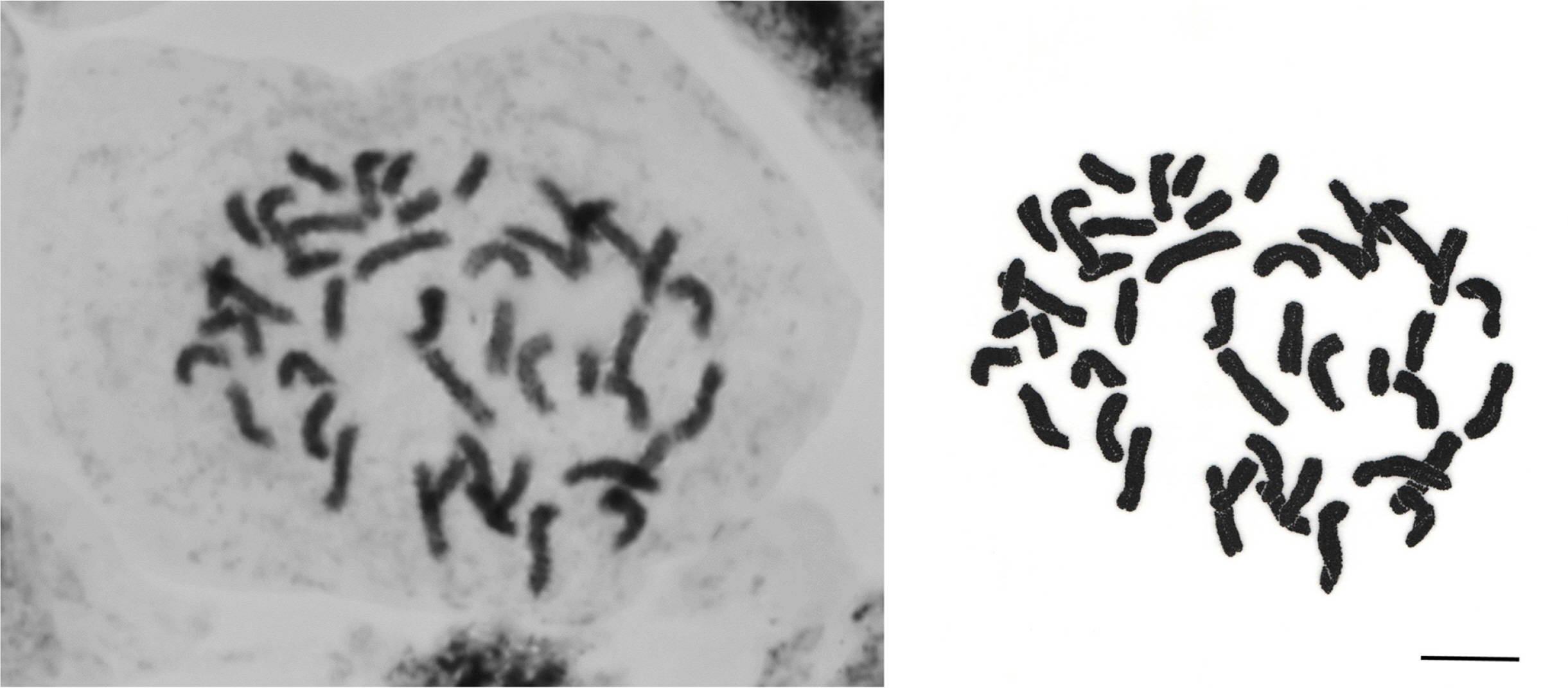Chromosome number of myoga ginger (Zingiber mioga: Zingiberaceae) in Korea
Article information
Abstract
The chromosome number of myoga ginger (Zingiber mioga (Thunb.) Roscoe: Zingiberaceae) has been reported as 2n = 22 for Chinese plants and 2n = 55 for Japanese plants. We checked the chromosome number of Z. mioga in plants collected in Jeollabuk-do and Jeollanam-do, Korea, and counted 2n = 44, the first report of this number for the species. As the basic chromosome number of Z. mioga is thought to be x = 11, Z. mioga plants in China, Korea, and Japan appear to be diploids, tetraploids, and pentaploids, respectively. In finding the tetraploid race of Z. mioga in Korea, we can hypothesize that the pentaploid race in Japan is derived through the fertilization of reduced gametes of the diploid race and unreduced gametes of the tetraploid race.
Myoga ginger (Zingiber mioga (Thunb.) Roscoe: Zingiberaceae) is a perennial herb, native to tropical Asia (Makino et al., 1961). It is cultivated for its edible flowers (inflorescences) in Japan and edible and medicinal use in China (Wu and Larsen, 2000; Ohba 2016). In Korea, however, it is only occasionally cultivated, and naturalized, mainly on the southern peninsula and on Jeju Island (Lee, 1996, 2006; Jung et al., 2016; Korea National Arboretum, 2016; Kim and Kil, 2016).
The chromosome number of Z. mioga has been reported to be 2n = 55 in Japanese plants (Morinaga et al., 1929; Takenaka, 1932; Sato, 1960; Suzuka and Mitsuoka, 1968) while 2n = 22 has been reported for the species in China (Chen et al., 1982). As the basic chromosome number of Z. mioga may be x = 11, the plants in Japan are pentaploids, while those in China are diploids. We were therefore intrigued to know the ploidy level of Z. mioga in Korea, an area between the diploid and pentaploid races.
Materials and Methods
We collected plants of Z. mioga at two localities in Korea and transplanted them to the nurseries of the Korea Research Institute of Bioscience & Biotechnology (Daejeon, Korea) and to the University of Tokyo (Tokyo, Japan) to be used for cytological investigation (Table 1).
Root tips were pretreated with a 2 mM 8-hydroxyquinoline solution at 20°C for 1 h and consequently at 4°C for 15 h before being fixed with Newcomer's fluid (see Sharma and Sharma, 1980). Fixed root tips were macerated in 1 N HCl for 10 min at 60°C. After washing with distilled water, they were stained with 2% lacto-propionic orcein. Slide preparations were made by the conventional squash method.
Results and Discussion
The chromosomes of Z. mioga in Korea were counted as 2n = 44 (Fig. 1). Counts of 2n = 22 (Chen et al., 1982) and 2n = 55 (Morinaga et al., 1929; Takenaka, 1932; Sato 1960; Suzuka and Mitsuoka, 1968) have been reported for Z mioga. The report of 2n = 44 is therefore the first for this species. As the basic chromosome number of Z. mioga is thought to be x = 11, 2n = 44 for Z. mioga in Korea may be a tetraploid.

Photomicrograph (left) and drawing (right) of somatic chromosomes of Zingiber mioga from Korea (2n = 44). Scale bar = 5 μm.
Polyploidization plays an important role in the diversification of plants (Grant, 1981; Soltis and Soltis, 2009; Soltis et al., 2009), and also impacts crop domestication and establishment of important agronomic traits (Hancock, 2005; Renny-Byfield and Wendel, 2014; Zhang et al., 2019). Therefore, Z. mioga is thought to have been improved through polyploidization from the diploid race in China to a pentaploid race in Japan. It has been difficult, however, to explain the process of establishment of pentaploids directly from diploids, since additional steps are needed in the polyploidization process. In finding the tetraploid race of Z. mioga in Korea, we can hypothesize that the pentaploid race is derived through fertilization of reduced gametes of the diploid race and unreduced gametes of the tetraploid race. Although it is just a hypothesis, we may be able to clarify the process of the establishment of the pentaploid race of Z. mioga through further cytological and molecular investigations of these cytotypes.
Acknowledgements
We appreciate Dr. David E. Boufford, Harvard University, for checking the English manuscript. This study was partly supported by JSPS KAKENHI Grant Number 17K07527 for H.I.
Notes
Conflict of Interest
The authors declare that there are no conflicts of interest.

